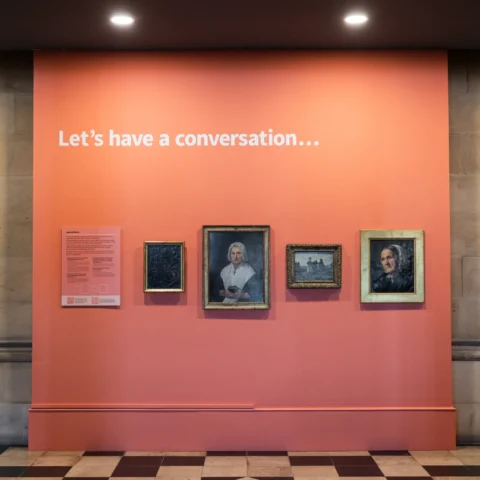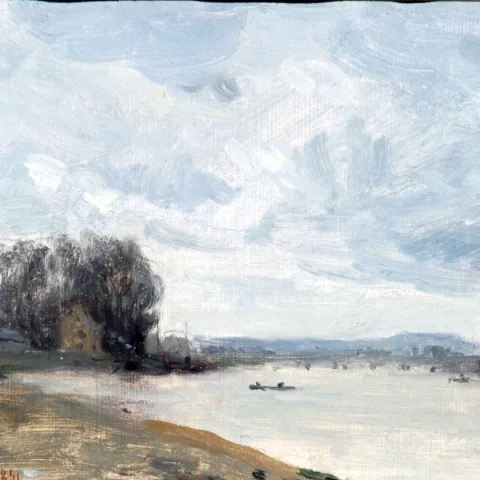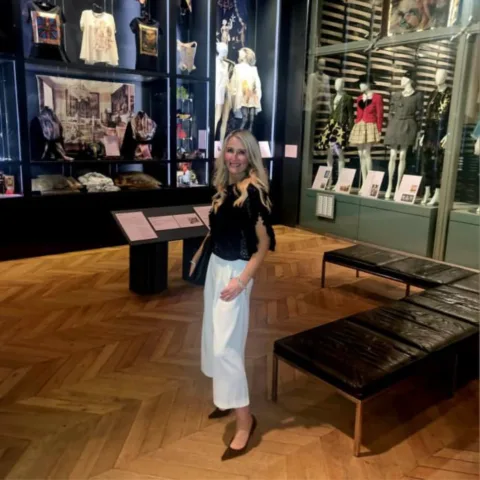The Bowes Museum Blog

English Rose: Putting Your Best Face Forward – Cosmetics in 18th Century Society Portraits
Over the centuries changing fashions can be observed in the sitter’s dress and style. The two beauties of Bath, Elizabeth and Mary Linley even had their portrait by Thomas Gainsborough altered to reflect current fashions in their style of dress. The sisters were famous for their musical talents. During the 18th century women were acknowledged and admired for their beauty, much like the celebrity culture of today.

Elizabeth and Mary Linley, Thomas Gainsborough, c.1772, retouched 1785
At this time the growing fashion for wearing make-up began to influence painterly styles. The increasing vogue for cosmetics began to shape the ideal of beauty. Artificial aids were very popular and widely used to enhance the appearance, giving the pale complexion and rosy cheeks synonymous with English beauty at the time. A smoothness and evenness of complexion was associated with moral purity.
In the portrait of Sarah Siddons by Thomas Gainsborough, her pink lips and rosy cheeks show the trend and acceptance of make-up in society. Lips were painted in a rose-bud shape with bright ceruse to give a bee-stung effect. Eyebrows were pencilled in, slim and dark while the natural brow was hidden. Sarah Siddons was the outstanding tragic actress of her time. She tried to emphasise her naturally pale complexion on stage and in her portraits to imitate the ‘timeless nobility of the antique’.

Mrs Siddons, Thomas Gainsborough, 1785
The connection between oil painting and cosmetics was physical as well as aesthetic. Ingredients for make-up used the same pigments as an artist’s palette. Women mixed their own lotions as artists would prepare their paints, it was only by the 18th century that ready-made cosmetics became available. Before this, women would mix their cosmetics in shells. Rouge was applied using Spanish wool, a pad of hair, saturated with the bright pink colour. Its texture was similar to a brillo pad.
The dangers of cosmetic and paint ingredients were well-known to artists and fashionable ladies. Chemical components included white lead, mercury, arsenic and red carmine. Although it was well-known that the use of lead could lead to fatal poisoning, white lead was still used in powders and lotions. To make a dangerous but effective face whitener, white lead was mixed with vinegar or borax and egg. Health risks from lead based mixtures included losing teeth, as lead attacked the enamel. It also was common for hair to fall out. To compensate for the unfortunate side-effects wigs and false teeth were worn. Vermillion was used by ladies as rouge for their cheeks, however it was also highly toxic. Cochineal papers were recommended instead to apply blush in a triangular shape.
Celebrated beauty, Maria Gunning climbed her way out of near-poverty to become the Countess of Coventry. Her story exemplifies the growing awareness of public image in 18th century Britain. Maria used her infamous reputation for beauty for social mobility, marrying the 6th Earl of Harrington in 1752.
Maria and her sister had humble beginnings as actresses in Dublin. Embarking on acting careers to improve the family fortunes, fate granted the sisters a fairy tale twist. Maria and Elizabeth were invited to a ball hosted at Dublin Castle by Viscountess Petersham. Too impoverished to have ball gowns for the occasion, the sisters were loaned the costumes of Lady Macbeth and Juliet from theatre owner, Tom Sheridan. Their charm, wit and beauty made such an impact that the sisters were able to secure a pension from the Earl of Harrington, who they were introduced to at the ball.
With an income secured, the sisters were swept back to the family home in England, where they entered society and grew their popularity as famous beauties. The 6th Earl of Coventry so admired her, that they were married in 1752. While on honeymoon in Paris, Maria was taken with the fashion for a pale complexion and brightly rouged cheeks. Her husband was less fond of cosmetics and was said to chase her round the dinner table with a handkerchief to remove it from her face.

Maria, Countess of Coventry, by Richard Houston, 1750-60, National Portrait Gallery
On return home, Maria continued to paint her face. She whitened her skin with the compound, ceruse. Ceruse was comprised from a deadly concoction of lead oxide, hydroxide, and carbonate. These chemicals combined with moisture in the skin to form acids that slowly ate the skin away. She used a red plant dye, containing poisonous mercury, to paint her lips.
As a gift for his beautiful wife, the Earl purchased a 7ft, elaborately carved, gilt wood mirror. Unfortunately Maria was only to treasure it for seven months. The lead in ceruse caused skin eruptions. In attempts to hide the unsightly condition, women would apply even more of the deadly mixture. Maria died aged only 27 and became known in society circles as a ’victim of cosmetics’.
Without the generous support of the loaning institutions, this exhibition would not have been possible.
By Caroline Potts, Curatorial Intern







